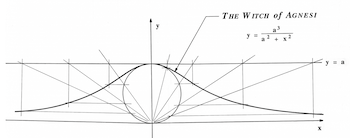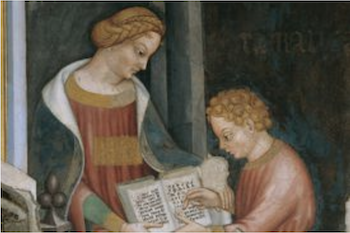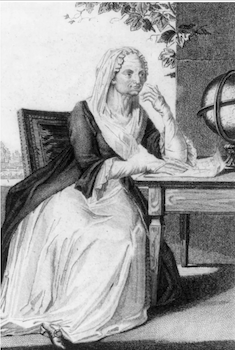
Born on May 16th, 1718 in Milan Italy, Maria Gaetana Agnesi was the oldest of 21 children brought up in a wealthy family. Her upbringing was one of privilege: the Agnesi’s made their family fortune from silk. Growing up as the daughter of Pietro Agnesi, it was ensured that Agnesi’s position as his eldest daughter meant she had accessibility to the best tutors that Milan had to offer. She never formally attended an educational institution and pursued her education at home. Throughout her studies, Agnesi was declared a child prodigy. She was quick to master several languages, and her father sought to display her intelligence during seminars alongside some of the brightest men in the area. After her mother’s death in 1732, she took on a more prominent role in the Agnesi household and retired from the public eye–likely the reason she never got married.

As she played the role of the primary housekeeper, Agnesi never gave up on her mathematics. In 1738, she published Propositiones Philosophicae (Propositions of Philosophy) which was a series of essays based on the discussions of intelligent men who would gather at her household. From a precarious position as an educated woman in the 1700s, her essays held the belief that women deserved an education. Barely in her 20s, Agnesi began working on her most famous work: Analytical Institutions. Agnesi’s major contributions to mathematics revolved around calculus, and this was the idea the book highlighted. Beginning as a textbook for her brothers, her efforts blossomed into a tangible record of knowledge and new discoveries in integral and differential calculus.

Her most lasting contribution, dedicated to her namesake, is the curve covered in Analytical Institutions called “The Witch of Agnesi.” Her diagram was called “versiera,” derived from vertere (Latin), meaning “to turn” because her diagram depicts a sine curve: an oscillating geometric wave. Vertere is also an abbreviation for an Italian word avversiera, translating to “wife of the devil”. During the translation of Analytical Institutions from Italian to English, “versiera” was mistaken as “witch,” so this curve eventually came to be known as “The Witch of Agnesi.” Her work was so well-renowned that she was rewarded with a gift from her nation’s queen. In addition, she was not only granted a mathematics degree from the University of Bologna but also offered a faculty position despite never having a formal degree. However, she never accepted the offer and dedicated the latter half of her life to a life of virtue and charity.
Having gripped the world by storm as a woman who introduced innovative solutions to one of calculus’s undiscovered theories, Agnesi retired from her mathematical career at age 34 when her father died. She turned to her religion and lived devoutly as a proud Catholic woman, dedicating her time and energy to helping the less fortunate. After having dedicated much of her fortune to her religious studies and charitable work, Agnesi died on January 9, 1799 at the age of 81 in poverty at a poorhouse she once directed. Her life in the 1700s, though unconventional, inspired countless mathematicians, women, and others through her introspective perspective of math, her fluency in multiple languages, and the purpose she devoted her life to. Agnesi was a remarkable woman, with her cubic curve found in calculus textbooks all over the world, a symphonic musical arrangement in her honor, and a crater on planet Venus named after her.
Why Did I Choose to Research Maria Gaetana Agnesi?
Knowing from a young age that I wanted to pursue STEM, I immersed myself in the experiences available, whether that be classes that circulate around the maths and sciences, or summer classes that provide extra context to the world of STEM. The ratio of women to men was miniscule and isolation is a feeling me and other women in STEM experience. Because of this, I knew I wanted to highlight a woman who broke barriers in the most inspiring of ways. Calculus is my favorite subject and researching monumental women in this field, Maria Gaetana Agnesi, was one of the most inspiring to me. Her humble demeanor and willingness to help those in need, near abandoning her fame in the mathematics realm struck me as intrinsically human, and very relatable.
Works Cited
Britannica, T. Editors of Encyclopaedia (2024, May 12). Maria Gaetana Agnesi. Encyclopedia Britannica. https://www.britannica.com/biography/Maria-Gaetana-Agnesi
Hayes, A. (2019). Sine Wave Definition. Investopedia. https://www.investopedia.com/terms/s/sinewave.asp
Maria Agnesi - Biography. (n.d.). Maths History. https://mathshistory.st-andrews.ac.uk/Biographies/Agnesi/
Maria Gaetana Agnesi. (2018). Physics Today. https://doi.org/10.1063/pt.6.6.20180516a
Quotes. (n.d.). Witchofagnesi.org. Retrieved July 30, 2024, from https://witchofagnesi.org/Quotes/Quotes.html#:~:text=%22For%20it%20is%20very%20well
This article was published on 9/4/24